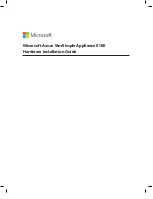
Ethernet Switch User Manual
Manual_cmd_line_config-ESML6-P3-Rev1106
Copyright © KBC Networks Ltd.
Page 26 of 49
www.kbcnetworks.com
7.2.8
Configuring DSCP priority mapping
The default mapping relations are shown in the following table:
IP DSCP priority
Priority
47 – 63
Queue 3 (highest priority)
32 – 47
Queue 2 (high priority)
16 – 31
Queue 1 (low priority)
0 – 15
Queue 0 (lowest priority)
DSCP priority mapping configuration
SWITCH(config)# qos diff-serv dscp priority <0-63> map queue <0-3>
7.2.9
Showing QoS configuration
SWITCH#show qos
8
IGMP Snooping
8.1
Introduction
IGMP (Internet Group Management Protocol) is a part of the IP protocol which is used to
support and manage IP multicast between hosts and multicast routers. IGMP Snooping is
used to restrict the spread of multicast data in Layer 2 and to monitor and analyze IGMP
messages. Multicast data is forwarded based on the set up between the port and the
multicast MAC address. When multicast data is received the switch will know which port
should receive the transmitted multicast data. IGMP Snooping also allows the switch to
be able to track all network group members that are physically connected to the switch.
The ESML6-P3 also supports a message auto-query function, so that the switch can be
added to the network without a Layer 3 switch or router. It supports the auto-query
restraint function which prevents the query message increasing as switches are added.
this ensures that the multicast service is able to reach the receiving end if a selected
switch is not functioning correctly.
The general query time is 125 seconds according to the IGMP protocol and the maximum
responding time is 10 seconds, if the network topology changes, the recovery time of
multicast services is up to 135 seconds. DT-Ring, DT-Ring+ and the RSTP protocols have
a topology changing informing system which can reduce the recovery time of the
multicast service to less than 5 seconds. It is recommended to use IGMP Snooping
together with DT-Ring, DT-Ring+ & RSTP protocols.
Note:
The maximum number of multicast addresses in the switch is 256, this must not
be exceeded.
















































